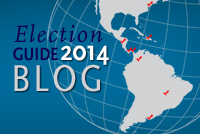2014 Election Blog: Latino Voting Bloc Grows, but Turnout Low
Voter turnout among the United States' Latino electorate remains lower than that of other blocs, but could increase as its young population ages.
More U.S. Latinos than ever are eligible to vote in this year's midterm elections, with a record 25.2 million Latino adult citizens living in the country. The approaching November 4 midterms have spurred discussion over Latinos' clout in national politics, spotlighting a voting trend: turnout among Latinos is lower than other demographic groups. In the last midterm election in 2010, Latino turnout was nearly 13 percent below that of blacks and 18 percent below that of whites. But, while turnout is expected to remain low in the short term, the future impact of the voter bloc could change, given that it is projected to account for 40 percent of growth in the national electorate in the next two decades.
Low turnout levels among Latinos stem from two primary factors: the relative age of the Latino electorate and their concentration in states and districts deemed non-competitive, which diminishes voters’ sense of needing to vote.
“The youth of the Hispanic electorate, in particular, is worth noting,” says Jens Manuel Krogstad, a writer and editor for Pew Research Center's Hispanic Trends Project, in an email. “This year, one in three…Hispanic eligible voters are ages 18 to 29, compared with 18 percent among whites, 25 percent among blacks, and 21 percent among Asians.” Krogstad says young people in general are less likely to vote, regardless of their ethnicity. The tendency's effect on Latino turnout is clear: in 2012, only 37 percent of Latino citizens ages 18 to 29 voted, compared to 48 percent of all Latino citizens and 62 percent of eligible voters nationwide.
Several nonpartisan organizations have launched get-out-the-vote campaigns to respond to the low turnout rates, including Voto Latino, which targets young Latinos. Two groups, National Council of La Raza and Mi Familia Vota have registered 80,000 voters in 2014, a number that exceeds the amount registered ahead of the 2012 presidential election. Similar campaigns have seen success in recent years: between the elections in 2010 and 2012, the number of registered Latino voters grew from 11 million to 23.7 million, a 24 percent increase. In contrast, the number of eligible Latino voters grew 9 percent.
Krogstad says low turnout levels may change as young Latinos age, since voter participation levels typically rise with age for all other demographic groups. “Also, the map of specific national elections could be different in the future than they are today,” Krogstad said. “That means that Latinos may play a bigger role in future elections if states like California or Texas become important in presidential elections.”
But some say an increase in turnout is unlikely when the November 4 midterm comes around. Latino turnout is already especially low during off-year elections like November's—just 31.2 percent of eligible voters cast their ballots in 2010. Additionally, disenchanted Latino voters may stay home following President Barack Obama's September reversal on a promise to executively enact comprehensive immigration reform, according to The Los Angeles Times. Plus, new voter ID laws in several states could hinder Latino voters. On October 18, the U.S. Supreme Court upheld a voter ID law in Texas, home to approximately 3.8 million eligible Latino voters. In her dissent, Justice Ruth Bader Ginsberg wrote that the law "may prevent more than 600,000 registered Texas voters (about 4.5 percent of all registered voters) from voting for lack of compliant identification...[and] a sharply disproportionate percentage of those voters are African-American or Hispanic.”







